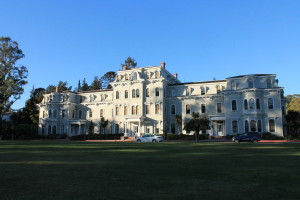
On the television screen mounted to the wall, a woman in a cocktail dress stands on an imposing ladder against the border fence that separates Playas de Tijuana from the Border Field State Park of San Diego. The woman is artist Ana Teresa Fernández, and the short film is called “Erasing the Border” (Borrando La Frontera) which features Fernández painting the bars of the border a foggy blue that matches the backdrop of ocean and sky.
Fernández’s short film is one of eleven works on display at the Slide Space 123 exhibit, “Resistance Training,” curated by Associate Adjunct Professor and art writer Glen Helfand.
Mills College alum Akari Goda-Maurezzutt said Fernández visited her Beginning Painting class and explained the effect of her work: When you step away from the painted border, it fades into the similarly colored background and becomes indistinguishable. The message is especially striking alongside daily news headlines and the Trump administration’s plan to transform the Mexican border into a wall.
In the wake of the presidential election, the committee that organizes Slide Space 123 exhibits realized the necessity of artists and activists creatively working together to resist the Trump administration. As the fall semester drew to a close, the Slide Space committee worked with artists to put together “Resistance Training.” The exhibit opened to the public on Jan. 18, just two days before the inauguration, according to Isabelle Chiosso, the art department’s faculty administrative assistant.
Helfand’s curatorial statement describes “Resistance Training” as a “first gesture that coincides with mass protests, grassroots actions and personal gestures.” The exhibit is presented as a “space to gather, to create community” and an example of what artistic and engaged community resistance could look like.
“It’s meaningful to tackle this topic at a place like Mills to begin a conversation,” Helfand said. “For anyone who went to the Women’s Marches in Oakland or San Francisco, or saw coverage of it, the sense of wit and creativity that went into the protest signs was hard to ignore. There was an amazing energy that was tapped.”
The team behind “Resistance Training” plans to utilize this momentum within the Mills community and has planned more events in the future.
On Feb. 2, “Resistance Training” will collaborate with 100 Days Action, a group started by artists to counter Trump’s first one hundred days in office, to present “Not My Precedent,” a panel discussion in Danforth Hall at 7 p.m. on the potential use of Japanese internment camps as precedent for a registry that would target immigrants from Muslim countries.
On Feb. 4, artist Melissa Wyman, whose work is also on display in the exhibit, will hold a participatory workshop of her project, Collaborative Combative Drawing in Art Room 115A, from 1-3 p.m.
The “Resistance Training” exhibit will run Monday through Friday, from 9 a.m. to 5 p.m. until Feb. 10.



